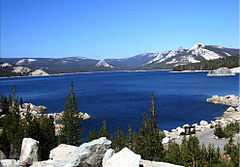Courtright Reservoir
| Courtright Reservoir | |
|---|---|
 | |
| Location | Fresno County, California |
| Coordinates | 37°06′11″N 118°58′26″W / 37.10297°N 118.97387°WCoordinates: 37°06′11″N 118°58′26″W / 37.10297°N 118.97387°W |
| Type | reservoir |
| Primary inflows | Helms Creek |
| Primary outflows | Helms Creek |
| Basin countries | United States |
| Surface elevation | 8,170 ft (2,490 m) |
Courtright Reservoir is a reservoir in Fresno County, California. The reservoir is at an elevation of 8,170 feet (2,490 m) in the Sierra National Forest, in the Sierra Nevada Mountain Range.
The reservoir is formed by Courtright Dam on Helms Creek and has a capacity of 123,300 acre feet (152,100,000 m3). The dam is composed of rock-fill and is 315 feet (96 m) tall, measured from the crest to the original streambed. It was completed in 1958 and is owned by Pacific Gas and Electric. Its primary purpose is hydroelectricity production.
In addition to conventional hydroelectricity production, Courtright Reservoir also serves as the upper reservoir for the Helms Pumped Storage Plant. Wishon Reservoir, a couple of miles downstream, is the lower reservoir. During times of peak demand for electricity, which is also when it is most expensive, water is drained from Courtright Reservoir, run through the 1,212 MW Helms Power Plant and empties into Wishon Reservoir. When demand and prices for electricity are low, water is pumped from Wishon Reservoir to Courtright Reservoir using the power plant's reversible turbines. Helms Power Plant is 1,000 feet (300 m) underground in a chamber carved out of solid granite at the north end of Wishon Lake. It is similar to Southern California Edison's Eastwood Powerhouse near Shaver Lake, which is also a pumped-storage plant.
Courtright reservoir is a haven for weekend and outdoor enthusiasts seeking to camp, fish, hike, boat, swim, rock climb, and 4x4 among others. It is surrounded by unique domes of granite that are essentially in the center of the Sierra Batholith and are highly sought after by rock climbers from all around. It is also used during warmer-weather months by local astronomers, such as members of the Central Valley Astronomers, who take advantage of its excellent location for night sky viewing free from light and air pollution.[1]
See also
References
- United States Forest Service
- United States Geological Survey
- California Public Utilities Commission PDF (84.8 KiB)